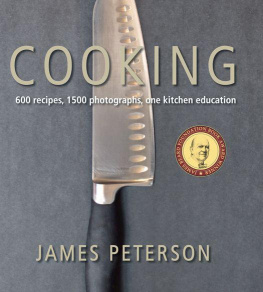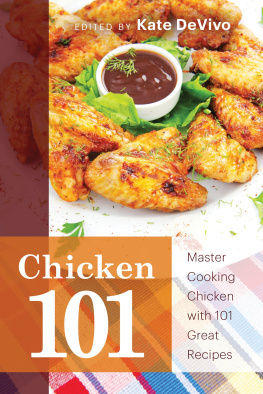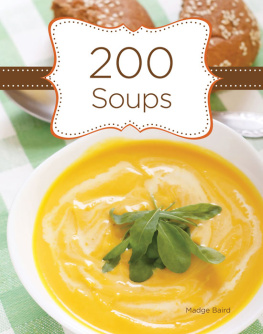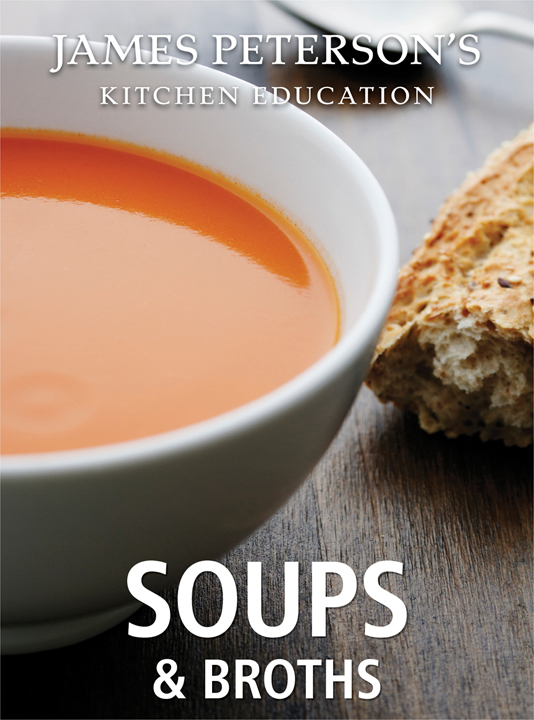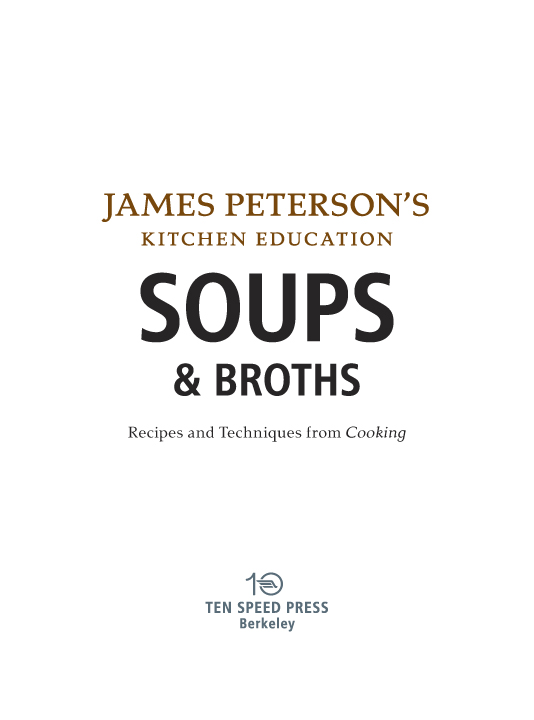2012 Ten Speed Press eBook Edition
Copyright 2007, 2012 by James Peterson
Photographs copyright 2007 by James Peterson
All rights reserved.
Published in the United States by Ten Speed Press, an imprint of the Crown Publishing Group, a division of Random House, Inc., New York.
www.crownpublishing.com
www.tenspeed.com
Ten Speed Press and the Ten Speed Press colophon are registered trademarks of Random House, Inc.
This work, with a new introduction, is comprised of material from Cooking by James Peterson, originally published in hardcover in the United States by Ten Speed Press, an imprint of the Crown Publishing Group, a division of Random House, Inc., Berkeley, in 2007.
Library of Congress Cataloging-in-Publication Data
Peterson, James.
Cooking / James Peterson.
p.cm.
1. Cookery I. Title
TX652.P455 2007
641.5dc22
2007021065
eISBN: 978-1-60774-400-9
V3.1
CONTENTS
AUTHORS NOTE
James Petersons Kitchen Education is a series of electronic booklets featuring the most popular topics from my book, .
Each booklet opens with a section called . This is where I describe some of my preferences for particular ingredients and make recommendations for special equipment you might need to prepare these recipes.
The an ingredient, this is where youll find a clear definition.
contains explanations and photography covering the ten basic cooking techniques that any cook needs in the kitchen: roasting, braising, poaching, sauting, steaming, frying, grilling, smoking, barbecuing, and boiling. You wont need to know all of these techniques to make the recipes in this booklet, but they are used often in cooking and will be a good general reference.
, in case you need to convert your measurements from cups to milliliters, ounces to grams, or vice versa.
Feel free to scroll through the book and check out your favorite recipes. Weve included lots of links to make it easy for you to jump around. While not essential, I do recommend that you read before you hit the kitchen. That way, the recipes reinforce what youve learned about each particular cooking technique that youre going to undertake.
Most of all, I hope you enjoy yourself. Cooking (and, to my mind, creativity in general) is about having fun and being relaxed. The anxiety-ridden, too-complicated meal is destined to fail while something simple and spontaneous is almost always sure to work. Good luck!

ASSUMPTIONS
I dont believe in observing a lot of rules when I cook, but I do have strong preferences about what makes cooking taste best.
INGREDIENTS
Baking powder: All baking powder is double-acting; its almost impossible to find any other version on grocery store shelves.
Bay leaves: Use the imported European variety, not those from California where the leaves have an aggressive eucalyptus flavor and aroma.
Butter: All butter is unsalted. If you only have salted butter, dont worry, just cut down on the salt in the recipe. If youre trying to make , youll have to use unsalted. And be aware that salted butter tends to burn a bit more easily than unsalted butter.
Cooking wine: Despite its virtues being extolled in many an old French cookbook, dont pour an expensive bottle of Bordeaux over a pot roast. True, a wine with bottle age gives wonderful flavor to anything braised, but unless youre set up with a cellar that guarantees you mature wine, dont buy aged wine for cooking unless youre very wealthy and dont care. In general, use white wine with a lot of acidity, which typically means French but not necessarily expensive; a generic Sauvignon Blanc is usually the right price and provides the requisite acidity and a bit of character youll need for beurre blanc or for meats braised in white wine. For red, go for a lot of body. Red wines from South America are often a good value and wines that might be too soft to drink, such as a generic Merlot, are perfect for the pot. Zinfandel was once a great value but no longer, unless you happen onto a sale. Wine that youve had around too long and that is a bit madeirized (white) or has lost its color (red) is perfect for cooking, and in fact the defects of wine gone bad can turn delicious when simmered with vegetables, meat, and herbs. Sherry, provided its dry, is often delicious in place of regular white wine, and white vermouth is great to have around in a pinch when the only wine around is rare white Burgundy that friends brought to drink with dinner. When you are completely desperately out of wine, wine vinegar, especially your own homemade, will serve as a passable substitute.
Meat glaze: Use either (take your best broth and reduce it to one-fifteenth its original volume) or a commercially available glaze, which can be the equivalent of broth reduced to one-thirtieth of its original volume.
Nut oils: These are notoriously perishable and are often rancid before you even open the bottle. The best way to avoid rancidity is to buy oil made from roasted nuts; the roasting greatly slows down rancidity. These oils are expensive, but very little is needed to flavor foods, so you end up using less than you would of a less expensive oil.
Salt: All salt is regular fine salt unless otherwise stated. If you have it, use fine sea salt as your basic salt, but otherwise regular when it rains it pours salt will be fine.
EQUIPMENT
Benriner slicer: Plastic vegetable slicers are convenient and less expensive alternatives to professional-style metal mandolines. For some tasks, the Benriner works better than its pricey cousin. Be sure to buy the Benriner brand, which has adjustable nuts that enable you to control the thickness of the slices (some brands have set inserts for creating various thicknesses and these are rarely the right size).
Cookware: Much is made about the materials used to make cookware, but it doesnt make an enormous difference if you cook in a copper pot or an aluminum one. Just remember that the pots and pans should be heavy so they cook evenly and dont get too hot in the areas right over the heat source. The best bargains are cast iron skillets, commonly found in hardware stores. Theyre heavy and, once seasonedheat a few tablespoons of vegetable oil in the pan until it smokes, then rub in the oil with a ragcan be used for just about anything. Aluminum pans, often found at restaurant supply stores, are also a good value; just keep in mind that aluminum saut pans must be very hotthe oil in them should smokeor food cooked in them will stick. Aluminum saucepans should never be used for sauces or soups containing egg yolks, or the liquid will turn gray.
Cooling racks: If you find a circular cake rack, nab it; theyre perfect for improvising steamers. Otherwise just buy a large enough rack to cool at least a sheet pan full of cookies.
Kitchen towels: These are indispensable and should be sturdy and made of cotton (polyester doesnt absorb liquids). Dont use terry-cloth towels, which easily catch fire and leave lint on surfaces and foods.
Pots and pans:


